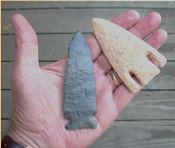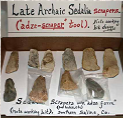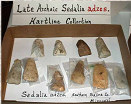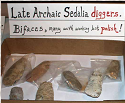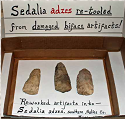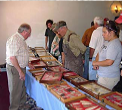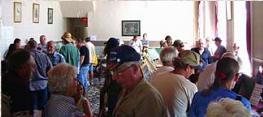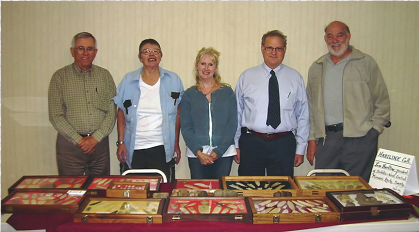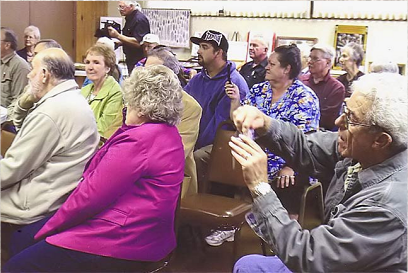



In some respects you and I share many of their traits. Each of us lives within a family or group with whom we identify. We unknowingly share with them a desire for security, comfort and a sense of belonging. Perhaps even more so, each of us share a preference for our favorite food, favorite clothing, favorite tools, favorite weather, favorite footwear, favorite shelter, favorite friend, etc….we share so much in common, yet
we are different in so many ways.You and I find ourselves satisfied with numerous meal choices while that luxury seldom existed for them. We have numerous choices as to what clothing we decide to wear each day while it seldom would have been a choice for them. For most of us, our tool boxes are chock-full of those we need, while their essential tools would have been organized and carried at their side in a bag. Almost daily we find ourselves adjusting our thermostats for more heat or cooling while they would not have enjoyed that luxury. While we take our refrigerators and freezers for granted, the best time for food preservation for them would have
been the winter season.You may ask, who are they and where did they come from? They are most commonly referred to as Indians, but more correctly they are Native Americans. Until relatively recently it was assumed they migrated to North America from Asia during the most recent ice age which peaked about 18,000 B.C. and ended by approximately 10,500 B.C. Crossing the land bridge from Asia into North America would have been entirely possible as the ocean level would have been hundreds of feet lower than today. This is what most of us were taught in our history classes…and we assumed this to be correct. Now, new evidence tells us, "Wait a minute, not so fast."
More and more credible information is surfacing to indicate the 'land bridge' theory may not be valid. One strong argument against immigration from Northeastern Asia lies in the fact no man-made tools and
More and more credible information is surfacing to indicate the 'land bridge' theory may not be valid. One strong argument against immigration from Northeastern Asia lies in the fact no man-made tools and
Indian Artifact Show
(free to the public)
Date: Saturday, June 25, 2011
Time: 10:00 A.M. to 3:00 P.M.
Place: Rotary Club Building
$1.00 raffle tickets will be available as a fund raiser with drawings to occur at 11:00 A.M. and 2:00 P.M. Raffle items will include replica artifacts, reference material and related items.
There will be displays by area/regional collectors of authentic Native American artifacts and early historical items. The public is invited to bring their personal artifacts for free identification as to type, age, culture and usage (no artifact will be bought, sold, traded or appraised). An experienced member of the flint knapping hobby will exhibit modern reproductions and demonstrate tools, stone and techniques required to make arrowheads.
For additional information contact:
(free to the public)
Date: Saturday, June 25, 2011
Time: 10:00 A.M. to 3:00 P.M.
Place: Rotary Club Building
Clinton, Missouri
Northwest corner of the square
Sponsor: Sedalia West-Central Chapter,Northwest corner of the square
Missouri Archaeological Society
Host: Henry County Historical Society$1.00 raffle tickets will be available as a fund raiser with drawings to occur at 11:00 A.M. and 2:00 P.M. Raffle items will include replica artifacts, reference material and related items.
There will be displays by area/regional collectors of authentic Native American artifacts and early historical items. The public is invited to bring their personal artifacts for free identification as to type, age, culture and usage (no artifact will be bought, sold, traded or appraised). An experienced member of the flint knapping hobby will exhibit modern reproductions and demonstrate tools, stone and techniques required to make arrowheads.
For additional information contact:
Rich Moore (Clinton, 660-885-3238),
Larry DesCombes (Leeton, 660-441-0635),
Dr. Tom and Jean Hoyne (Stover, 573-377-4149),
Tom Hartline (Marshall, 660-886-9479),
Tim Dunham (Otterville, 660-366- 4612) or
Tom Ragan (Sedalia, 660-826-7352).
Larry DesCombes (Leeton, 660-441-0635),
Dr. Tom and Jean Hoyne (Stover, 573-377-4149),
Tom Hartline (Marshall, 660-886-9479),
Tim Dunham (Otterville, 660-366- 4612) or
Tom Ragan (Sedalia, 660-826-7352).


The Battle of Marshall Civil War Survey was a success, though scaled down considerably from what we had hoped to do. Having Dr. Doug Scott, the father of battlefield archaeology, guiding us was a huge help, and brought us considerable media attention (we were all over the internet, including some mentions in England).
We are considering doing a bit more survey work in early May, possibly with Dr. Michael Fuller from St. Louis Community College, looking at weekends in early May.
Any Archaeology Society members interested in participating would be gladly accepted.
Sincerely,
Dr. Peter Warnock
We are considering doing a bit more survey work in early May, possibly with Dr. Michael Fuller from St. Louis Community College, looking at weekends in early May.
Any Archaeology Society members interested in participating would be gladly accepted.
Sincerely,
Dr. Peter Warnock

Frank Spicer, 94, passed away on Saturday, November 27, 2010 at the Missouri Veteran's Home, Warrensburg of complications resulting from pneumonia.
Mr. Spicer, a former resident of the Holden area, was a well-known and respected farmer, cattleman and dairyman in Johnson County. He was born August 17, 1916 at Route 1, Centerview, MO, the son of Vivian Edward and Ida Mitchell Spicer. He graduated in 1939 from Central Missouri State Teachers College with a degree in Industrial Arts. On April 24, 1943 he married Katye Nichols in Douglas, Georgia. Mr. Spicer served in World War II as a Crew Chief in the Army Air Corps from November 1941 until August 1945. He was awarded the Presidential Citation and the Air Medal with two Oak Leaf Clusters for Valor for his bravery on D-Day. He also received seven bronze stars for campaigns in the Rhineland, Central Europe, Ardennes, Northern France, Southern France, Normandy, and Italy. He was also given the American Defense Service Ribbon, three Overseas Bars, a Unit Citation Badge and the Good Conduct Medal. After the war, he and Katye moved to Johnson County where he returned to the family farm. Mr. Spicer and his late wife, Katye, were long-time members of the Blackwater Methodist Church.
Mr. Spicer was the former president of the Johnson County Farm Bureau and served on the boards of the Mid-America Dairy Board, Soil Conservation, M.F.A. and was member of the Federal Land Bank Board for twenty-four years. He was also a lifetime member of the Sedalia West Central Missouri Archaeological Society. During the last two and a half years of his life, he resided at the Missouri Veterans Home, Warrensburg where he was President of the Neighbors' Association. On September 30, 2009, he participated in an Honor Flight trip to Washington, D.C. with 39 other WWII veterans. At 93, he was the oldest person on the trip and one of the oldest veterans ever to make an Honor Flight trip.
He was preceded in death by his wife, Katye Nichols Spicer in 2007. He is survived by his daughter, Kathleen Spicer Doyle and her husband, Robert, of Overland Park, KS and one granddaughter, Karen Doyle Poland and her husband, Valor Poland of Seattle, Washington.
Burial will be private. Friends are invited to a visitation on Friday, December 3, 2010 from 6:00 to 8:30 p.m. at Williams Funeral Chapel, Warrensburg. A memorial service is scheduled for Saturday, December 4, at 3:30 p.m. also at Williams Funeral Chapel. Memorials may be sent to the Veterans Assistance League, Missouri Veterans Home, 1300 Veterans Road, Warrensburg, MO 64093.
Online condolences may be left at www.williamsfuneralchapel.net

The Sedalia West-Central Chapter of the Missouri Archaeological Society met for its September meeting in Stover, Missouri on September 26, 2010.
The subject of the program was recollections of the life of archaeologist Rolland Pangborn. Rolland is best known to many as the co-dicoverer with Dr. Raymond Wood of the famous jaguar gorget in Benton County, Missouri.
The subject of the program was recollections of the life of archaeologist Rolland Pangborn. Rolland is best known to many as the co-dicoverer with Dr. Raymond Wood of the famous jaguar gorget in Benton County, Missouri.

NATIVE AMERICAN ARTIFACT SHOW
IN CLINTON, MO - SATURDAY JUNE 26TH 2010
IN CLINTON, MO - SATURDAY JUNE 26TH 2010
collectors of authentic Native American artifacts and early historical items.
Many of those with an interest in our earliest Americans attended, viewed, discussed and asked questions about the numerous weapons and tools displayed by hunter/collectors from Western Missouri and the surrounding area. Visitors, one coming all the way from Switzerland, brought artifacts for cultural period identification and probable use. A flint knapper was present to demonstrate how Native Americans manufactured their stone weapons and tools.
The show is sponsored annually by the Sedalia West-Central Chapter of the Missouri Archaeological Society. Non-chapter members are encouraged to bring artifacts for display on a space available basis. Chapter By-laws prohibit the buying, selling, trading and appraising of authentic Native American artifacts.
Many of those with an interest in our earliest Americans attended, viewed, discussed and asked questions about the numerous weapons and tools displayed by hunter/collectors from Western Missouri and the surrounding area. Visitors, one coming all the way from Switzerland, brought artifacts for cultural period identification and probable use. A flint knapper was present to demonstrate how Native Americans manufactured their stone weapons and tools.
The show is sponsored annually by the Sedalia West-Central Chapter of the Missouri Archaeological Society. Non-chapter members are encouraged to bring artifacts for display on a space available basis. Chapter By-laws prohibit the buying, selling, trading and appraising of authentic Native American artifacts.
For thousands of years Clinton and the surrounding area was home to a number of Native American cultural groups. Although most don't give this fact a thought, proof is often found by hunter/collectors in the form of ancient arrowheads and other stone tools.
Many Native Americans utilized our area as hunting and home sites as they traveled the prairie in search of animals and plants for use as food, clothing and shelter. Among the last to have frequented our location were the Osage people who in the early 1800s, relocated to Indian Territory (Kansas) after giving up their land in this area to the U.S. Government. Immigrant white settlers from the east were quick to begin homesteading the area vacated by the Osage.
The show was moved from Leeton to Clinton for 2010 to increase the available display space. It included displays by area/regional
Many Native Americans utilized our area as hunting and home sites as they traveled the prairie in search of animals and plants for use as food, clothing and shelter. Among the last to have frequented our location were the Osage people who in the early 1800s, relocated to Indian Territory (Kansas) after giving up their land in this area to the U.S. Government. Immigrant white settlers from the east were quick to begin homesteading the area vacated by the Osage.
The show was moved from Leeton to Clinton for 2010 to increase the available display space. It included displays by area/regional

Article regarding the Sedalia - West Central Missouri Archaeology Society meeting on September 26, 2009:
On the evening of September 26, 2009, the Sedalia West-Central Chapter of the Missouri Archaeological Society held its monthly meeting in Clinton at the Henry County Historical Society's DeLozier Building.
A number of people from Clinton and the surrounding area with an interest in archaeology were present with one person driving from St. Louis to attend. With 30 plus in attendance the program was presented by chapter member and artifact expert Dr. Tom Hoyne of Stover. His topic centered around the stone artifacts of the Late Archaic Sedalia Complex, with particular emphasis on the making and use of Sedalia diggers and Sedalia adzes of which many examples were on display. These tools are two of the trademark artifacts left behind in our area by the Sedalia people during the Late Archaic period. This period lasted from approximately 4,000 years to 3,000 years before the present time. Dr. Hoyne explained, due to the availability of good 10-40 power microscopes it is now possible to learn precisely the use of each of these tools by examining closely the wear patterns and scars that have developed through use. This knowledge allows us to better understand the lives of those who walked where we walk.
Dr. Hoyne stated the first serious research on the Sedalia culture was begun by the late Robert Seelan of Sedalia during the 1940-1960s timeframe. Although a non-professional archaeologist, Seelan became highly respected in the professional archaeologist community for his dedication and accuracy. Most of his research was conducted in the Sedalia area and he chose the name Sedalia to identify the tools and weapons of that culture.
It should be noted the Sedalia culture was not only present in Western Missouri, but evidence is found throughout almost the entire state, as well as a large part of Western Illinois, Southern Iowa, extreme Southeast Nebraska and a very small portion of Eastern Kansas.
After Dr. Hoyne's presentation and a question and answer session, there was much examination and discussion of artifacts while enjoying iced tea, coffee and cookies. Interesting and eerily true, after the presentation the following comment was made by a Clinton visitor, "You know, as we walk or drive about Henry County each day, our paths and those of the Sedalia people undoubtedly often cross. The only thing separating us is time."
Sedalia Chapter meetings are open to those of the public whose interest in Native Americans range from merely casual to a much stronger desire to further their knowledge of the weapons and tools used by early Americans.
Last, our Sedalia Chapter wishes to express its thanks to Dan Miles, Jr. and the staff at the Clinton Daily Democrat for their help in telling the public we would be in Clinton. Also, hats-off and thank you to Alta Dulaban, director of the Henry County Museum and Dwight Whitton, Sedalia chapter member and member/volunteer of the Henry County Historical Society for making the DeLozier building available.
Our Sedalia Chapter welcomes those with an interest in archaeology. Membership Chairperson is: Jean Hoyne, PO Box 198, Stover, Mo., 65078 573-377-4149
Best regards, Larry DesCombes
Missouri Archaeological Society, trustee emeritus
Sedalia West-Central Chapter-MAS, trustee
A number of people from Clinton and the surrounding area with an interest in archaeology were present with one person driving from St. Louis to attend. With 30 plus in attendance the program was presented by chapter member and artifact expert Dr. Tom Hoyne of Stover. His topic centered around the stone artifacts of the Late Archaic Sedalia Complex, with particular emphasis on the making and use of Sedalia diggers and Sedalia adzes of which many examples were on display. These tools are two of the trademark artifacts left behind in our area by the Sedalia people during the Late Archaic period. This period lasted from approximately 4,000 years to 3,000 years before the present time. Dr. Hoyne explained, due to the availability of good 10-40 power microscopes it is now possible to learn precisely the use of each of these tools by examining closely the wear patterns and scars that have developed through use. This knowledge allows us to better understand the lives of those who walked where we walk.
Dr. Hoyne stated the first serious research on the Sedalia culture was begun by the late Robert Seelan of Sedalia during the 1940-1960s timeframe. Although a non-professional archaeologist, Seelan became highly respected in the professional archaeologist community for his dedication and accuracy. Most of his research was conducted in the Sedalia area and he chose the name Sedalia to identify the tools and weapons of that culture.
It should be noted the Sedalia culture was not only present in Western Missouri, but evidence is found throughout almost the entire state, as well as a large part of Western Illinois, Southern Iowa, extreme Southeast Nebraska and a very small portion of Eastern Kansas.
After Dr. Hoyne's presentation and a question and answer session, there was much examination and discussion of artifacts while enjoying iced tea, coffee and cookies. Interesting and eerily true, after the presentation the following comment was made by a Clinton visitor, "You know, as we walk or drive about Henry County each day, our paths and those of the Sedalia people undoubtedly often cross. The only thing separating us is time."
Sedalia Chapter meetings are open to those of the public whose interest in Native Americans range from merely casual to a much stronger desire to further their knowledge of the weapons and tools used by early Americans.
Last, our Sedalia Chapter wishes to express its thanks to Dan Miles, Jr. and the staff at the Clinton Daily Democrat for their help in telling the public we would be in Clinton. Also, hats-off and thank you to Alta Dulaban, director of the Henry County Museum and Dwight Whitton, Sedalia chapter member and member/volunteer of the Henry County Historical Society for making the DeLozier building available.
Our Sedalia Chapter welcomes those with an interest in archaeology. Membership Chairperson is: Jean Hoyne, PO Box 198, Stover, Mo., 65078 573-377-4149
Best regards, Larry DesCombes
Missouri Archaeological Society, trustee emeritus
Sedalia West-Central Chapter-MAS, trustee

The Sedalia - West Central Missouri Archaeological Society, a chapter of the Missouri Archaeological Society, meets the fourth Saturday of every month (excluding January, November and December). Most meetings start at 7:00 PM and are held in the lower level of the Farm Credit Services building at 2600 S Limit Ave, Sedalia, MO, 65301. We have an annual artifact show.
On the evening of September 26, 2009, the Sedalia West-Central Chapter of the Missouri Archaeological Society held its monthly meeting in Clinton at the Henry County Historical Society's DeLozier Building.
A number of people from Clinton and the surrounding area with an interest in archaeology were present with one person driving from St. Louis to attend. With 30 plus in attendance the program was presented by chapter member and artifact expert Dr. Tom Hoyne of Stover. His topic centered around the stone artifacts of the Late Archaic Sedalia Complex, with particular emphasis on the making and use of Sedalia diggers and Sedalia adzes of which many examples were on display. These tools are two of the trademark artifacts left behind in our area by the Sedalia people during the Late Archaic period. This period lasted from approximately 4,000 years to 3,000 years before the present time. Dr. Hoyne explained, due to the availability of good 10-40 power microscopes it is now possible to learn precisely the use of each of these tools by examining closely the wear patterns and scars that have developed through use. This knowledge allows us to better understand the lives of those who walked where we walk.
Dr. Hoyne stated the first serious research on the Sedalia culture was begun by the late Robert Seelan of Sedalia during the 1940-1960s timeframe. Although a non-professional archaeologist, Seelan became highly respected in the professional archaeologist community for his dedication and accuracy. Most of his research was conducted in the Sedalia area and he chose the name Sedalia to identify the tools and weapons of that culture.
It should be noted the Sedalia culture was not only present in Western Missouri, but evidence is found throughout almost the entire state, as well as a large part of Western Illinois, Southern Iowa, extreme Southeast Nebraska and a very small portion of Eastern Kansas.
After Dr. Hoyne's presentation and a question and answer session, there was much examination and discussion of artifacts while enjoying iced tea, coffee and cookies. Interesting and eerily true, after the presentation the following comment was made by a Clinton visitor, "You know, as we walk or drive about Henry County each day, our paths and those of the Sedalia people undoubtedly often cross. The only thing separating us is time."
Sedalia Chapter meetings are open to those of the public whose interest in Native Americans range from merely casual to a much stronger desire to further their knowledge of the weapons and tools used by early Americans.
Last, our Sedalia Chapter wishes to express its thanks to Dan Miles, Jr. and the staff at the Clinton Daily Democrat for their help in telling the public we would be in Clinton. Also, hats-off and thank you to Alta Dulaban, director of the Henry County Museum and Dwight Whitton, Sedalia chapter member and member/volunteer of the Henry County Historical Society for making the DeLozier building available.
Our Sedalia Chapter welcomes those with an interest in archaeology. Membership Chairperson is: Jean Hoyne, PO Box 198, Stover, Mo., 65078 573-377-4149
Best regards, Larry DesCombes
Missouri Archaeological Society, trustee emeritus
Sedalia West-Central Chapter-MAS, trustee
A number of people from Clinton and the surrounding area with an interest in archaeology were present with one person driving from St. Louis to attend. With 30 plus in attendance the program was presented by chapter member and artifact expert Dr. Tom Hoyne of Stover. His topic centered around the stone artifacts of the Late Archaic Sedalia Complex, with particular emphasis on the making and use of Sedalia diggers and Sedalia adzes of which many examples were on display. These tools are two of the trademark artifacts left behind in our area by the Sedalia people during the Late Archaic period. This period lasted from approximately 4,000 years to 3,000 years before the present time. Dr. Hoyne explained, due to the availability of good 10-40 power microscopes it is now possible to learn precisely the use of each of these tools by examining closely the wear patterns and scars that have developed through use. This knowledge allows us to better understand the lives of those who walked where we walk.
Dr. Hoyne stated the first serious research on the Sedalia culture was begun by the late Robert Seelan of Sedalia during the 1940-1960s timeframe. Although a non-professional archaeologist, Seelan became highly respected in the professional archaeologist community for his dedication and accuracy. Most of his research was conducted in the Sedalia area and he chose the name Sedalia to identify the tools and weapons of that culture.
It should be noted the Sedalia culture was not only present in Western Missouri, but evidence is found throughout almost the entire state, as well as a large part of Western Illinois, Southern Iowa, extreme Southeast Nebraska and a very small portion of Eastern Kansas.
After Dr. Hoyne's presentation and a question and answer session, there was much examination and discussion of artifacts while enjoying iced tea, coffee and cookies. Interesting and eerily true, after the presentation the following comment was made by a Clinton visitor, "You know, as we walk or drive about Henry County each day, our paths and those of the Sedalia people undoubtedly often cross. The only thing separating us is time."
Sedalia Chapter meetings are open to those of the public whose interest in Native Americans range from merely casual to a much stronger desire to further their knowledge of the weapons and tools used by early Americans.
Last, our Sedalia Chapter wishes to express its thanks to Dan Miles, Jr. and the staff at the Clinton Daily Democrat for their help in telling the public we would be in Clinton. Also, hats-off and thank you to Alta Dulaban, director of the Henry County Museum and Dwight Whitton, Sedalia chapter member and member/volunteer of the Henry County Historical Society for making the DeLozier building available.
Our Sedalia Chapter welcomes those with an interest in archaeology. Membership Chairperson is: Jean Hoyne, PO Box 198, Stover, Mo., 65078 573-377-4149
Best regards, Larry DesCombes
Missouri Archaeological Society, trustee emeritus
Sedalia West-Central Chapter-MAS, trustee
Pictured: Dr. Bruce McMillin; Rolland's daughters
Billie and Vicki; Dr. Marvin Kay; Dr. Raymond Wood.
Billie and Vicki; Dr. Marvin Kay; Dr. Raymond Wood.
Not only were both of his daughters, Billie and Vicki, there to share memories of their father; but also present were Dr. Bruce McMillin, Dr. Raymond Wood and Dr. Marvin Kay. Each of these individuals were associated with Rolland at various times in their careers and graciously shared their fond and sometimes amusing memories of him. To say the least, Rolland Pangborn was a true professional and a most unique individual.
Our Sedalia Chapter is fortunate to have experienced such a gathering.
Special thanks are due Sedalia chapter member Dr. Tom Hoyne for his tireless work in arranging this event.
Our Sedalia Chapter is fortunate to have experienced such a gathering.
Special thanks are due Sedalia chapter member Dr. Tom Hoyne for his tireless work in arranging this event.
From the gathering to commemorate the life of Rolland Pangborn: Pictured in left foreground is Dr. W. Raymond Wood, professor emeritus, University of Missouri, and his wife, Carolee. Barely visible above Dr. Wood is archaeologist R. Bruce McMillin, University of Missouri, and to the right, his wife Virginia. Behind Mrs. Wood is Dr. Marvin Kay, head of the Department of Anthropology, University of Arkansas. To the far right is Larry DesCombes, retired history teacher and amateur archaeologist.
Click on pictures to view larger versions
Click on pictures to view larger versions
Click on pictures to view larger versions
Click on pictures to view larger versions


August 17, 1916 - November 27, 2010
Frank will be sorely missed by his friends here at the Sedalia Chapter of the Missouri Archaeological Society. Frank and his wife Katye, both members of the Society, had a collection of personal found artifacts that they shared with the archaeological society to our mutual enrichment.


Dr. Peter Warnock
Department of Anthropology
Missouri Valley College
Marshall, MO 65340
(660) 831-4044
Department of Anthropology
Missouri Valley College
Marshall, MO 65340
(660) 831-4044


On the Left:
a 7,000-5,000 year old
4 1/8" knife/spear point left behind in Johnson County by the Hemphill people.
On the Right:4 1/8" knife/spear point left behind in Johnson County by the Hemphill people.
a Calf Creek culture find from Henry County dated in the 8,000-5,000 year age range.
Both of these artifacts will be displayed at the June 25th Clinton Artifact show.
Both of these artifacts will be displayed at the June 25th Clinton Artifact show.
Click on pictures to view larger versions
weapons found in Northwestern North America resemble those found in Northeastern Asia. An argument receiving increasing acceptance claims our earliest peoples arrived from Europe.
Archaeological researchers are increasingly noting some stone tools and weapons from the ice age timeframe found in Western and Northwestern Europe are identical to those found along the east coast of the United States. One would ask why it would not be plausible for our earliest Americans to have arrived here from Europe.
When we consider the ocean level thousands of years ago to have been much lower, travel by water would have been safer. Land masses would have been in much closer proximity to each other, which would have meant less time in danger on an open sea.
Most of us unknowingly cross the thousands of year old paths of these ancient people each day. But regardless of how they arrived on the North American continent, evidence of their presence in West-Central Missouri is often found by hunter/collectors who search for it.
Archaeological researchers are increasingly noting some stone tools and weapons from the ice age timeframe found in Western and Northwestern Europe are identical to those found along the east coast of the United States. One would ask why it would not be plausible for our earliest Americans to have arrived here from Europe.
When we consider the ocean level thousands of years ago to have been much lower, travel by water would have been safer. Land masses would have been in much closer proximity to each other, which would have meant less time in danger on an open sea.
Most of us unknowingly cross the thousands of year old paths of these ancient people each day. But regardless of how they arrived on the North American continent, evidence of their presence in West-Central Missouri is often found by hunter/collectors who search for it.
You are invited to view hundreds of weapons and tools used by our earliest inhabitants on
June 25th at the Rotary Club building on the Northwest corner of the Clinton square.
June 25th at the Rotary Club building on the Northwest corner of the Clinton square.
